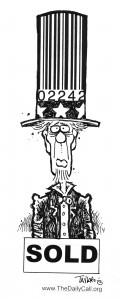“Major, give us a moment to kneel and pray.”
And the major said, “Troopers, advance!” And you saw these guys putting on their gas masks. They came toward us, beating us with nightsticks and bullwhips, trampling us with horses.
Democracy Now! (3/6/15)Thousands of people are expected to travel to Selma, Alabama, this weekend for the 50th anniversary of “Bloody Sunday,” when hundreds of peaceful voting rights activists were attacked by police crossing the Edmund Pettus Bridge as they attempted to march to Montgomery on March 7, 1965.
Bloody Sunday was the first of three attempted marches from Selma to Montgomery, which was finally completed under federal protection and led by Dr. Martin Luther King Jr. One of the protesters beaten on Bloody Sunday was Rep. John Lewis of Georgia, then a 25-year-old organizer with the Student Nonviolent Coordinating Committee.
“I was hit in the head by a state trooper with a nightstick. I had a concussion at the bridge,” Lewis said. “My legs went out from under me. I felt like I was going to die. I thought I saw Death. All these many years later, I don’t recall how I made it back across that bridge to the church.”
Link to Story and 10-Minute Video
- Youngest Marcher on Edmund Pettus Bridge Reflects — Sheyann Webb Christburg was 8 years old, the youngest person on the Edmund Pettus Bridge. She remembers the feeling of tear gas in her eyes, and she remembers running home when Rev. Hosea Williams, the civil rights leader, picked her up to carry her. She remembers saying, “Put me down because you’re not running fast enough.” Story and 2-Minute Video
- Who Was Edmund Pettis? The Racist History Behind The Iconic Selma Bridge — “Pettus was the head of the most notorious white terrorist group in Alabama probably up until the civil rights movement,” says John Giggie, who teaches Southern history at the University of Alabama. Aside from being a two-term U.S. senator and a Confederate general, Pettus was a Grand Dragon of the Alabama Ku Klux Klan. When legislators decided to name the bridge after him in 1940, Giggie says there’s no mistaking the message they wanted to send — especially given that the bridge, the gateway to Selma, was a huge engineering improvement over the previous one, an old swing bridge that had to be opened by hand. “They wanted to stamp that — to brand it — with this vision of the South as very much as a … a world dedicated to white supremacy,” says Giggie … Read the Rest and Link to 4-Minute Video





